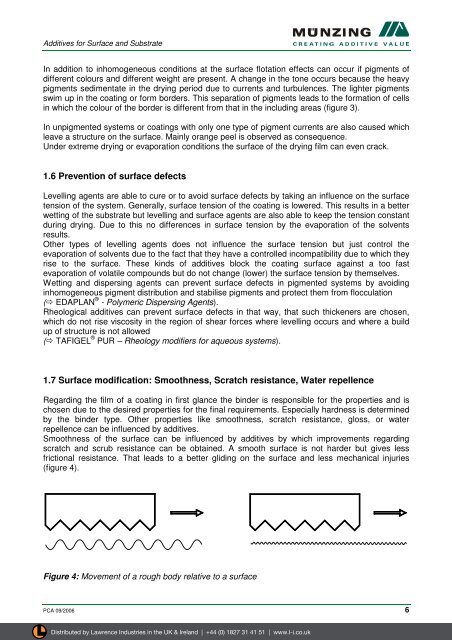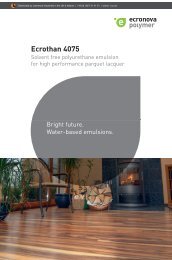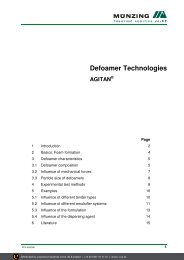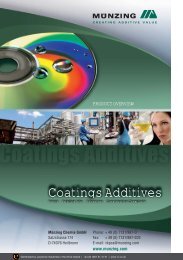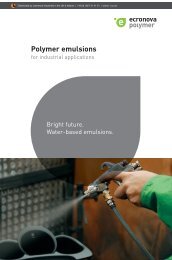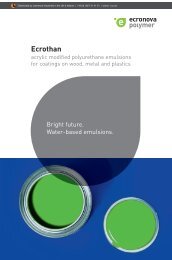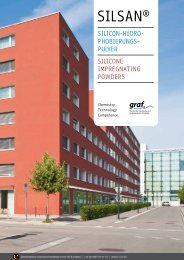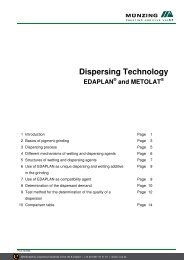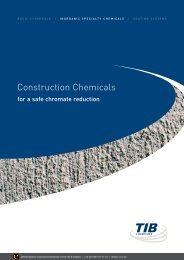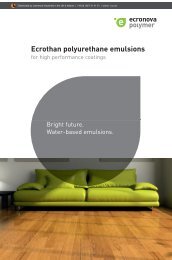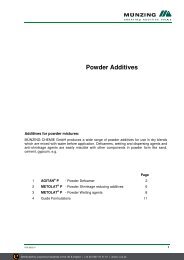Metolat & Edaplan LA - Additives for Surf⦠- Lawrence Industries
Metolat & Edaplan LA - Additives for Surf⦠- Lawrence Industries
Metolat & Edaplan LA - Additives for Surf⦠- Lawrence Industries
Create successful ePaper yourself
Turn your PDF publications into a flip-book with our unique Google optimized e-Paper software.
<strong>Additives</strong> <strong>for</strong> Surface and Substrate<br />
In addition to inhomogeneous conditions at the surface flotation effects can occur if pigments of<br />
different colours and different weight are present. A change in the tone occurs because the heavy<br />
pigments sedimentate in the drying period due to currents and turbulences. The lighter pigments<br />
swim up in the coating or <strong>for</strong>m borders. This separation of pigments leads to the <strong>for</strong>mation of cells<br />
in which the colour of the border is different from that in the including areas (figure 3).<br />
In unpigmented systems or coatings with only one type of pigment currents are also caused which<br />
leave a structure on the surface. Mainly orange peel is observed as consequence.<br />
Under extreme drying or evaporation conditions the surface of the drying film can even crack.<br />
1.6 Prevention of surface defects<br />
Levelling agents are able to cure or to avoid surface defects by taking an influence on the surface<br />
tension of the system. Generally, surface tension of the coating is lowered. This results in a better<br />
wetting of the substrate but levelling and surface agents are also able to keep the tension constant<br />
during drying. Due to this no differences in surface tension by the evaporation of the solvents<br />
results.<br />
Other types of levelling agents does not influence the surface tension but just control the<br />
evaporation of solvents due to the fact that they have a controlled incompatibility due to which they<br />
rise to the surface. These kinds of additives block the coating surface against a too fast<br />
evaporation of volatile compounds but do not change (lower) the surface tension by themselves.<br />
Wetting and dispersing agents can prevent surface defects in pigmented systems by avoiding<br />
inhomogeneous pigment distribution and stabilise pigments and protect them from flocculation<br />
( EDAP<strong>LA</strong>N ® - Polymeric Dispersing Agents).<br />
Rheological additives can prevent surface defects in that way, that such thickeners are chosen,<br />
which do not rise viscosity in the region of shear <strong>for</strong>ces where levelling occurs and where a build<br />
up of structure is not allowed<br />
( TAFIGEL ® PUR – Rheology modifiers <strong>for</strong> aqueous systems).<br />
1.7 Surface modification: Smoothness, Scratch resistance, Water repellence<br />
Regarding the film of a coating in first glance the binder is responsible <strong>for</strong> the properties and is<br />
chosen due to the desired properties <strong>for</strong> the final requirements. Especially hardness is determined<br />
by the binder type. Other properties like smoothness, scratch resistance, gloss, or water<br />
repellence can be influenced by additives.<br />
Smoothness of the surface can be influenced by additives by which improvements regarding<br />
scratch and scrub resistance can be obtained. A smooth surface is not harder but gives less<br />
frictional resistance. That leads to a better gliding on the surface and less mechanical injuries<br />
(figure 4).<br />
Figure 4: Movement of a rough body relative to a surface<br />
PCA 09/2006 6<br />
Distributed by <strong>Lawrence</strong> <strong>Industries</strong> in the UK & Ireland | +44 (0) 1827 31 41 51 | www.l-i.co.uk


